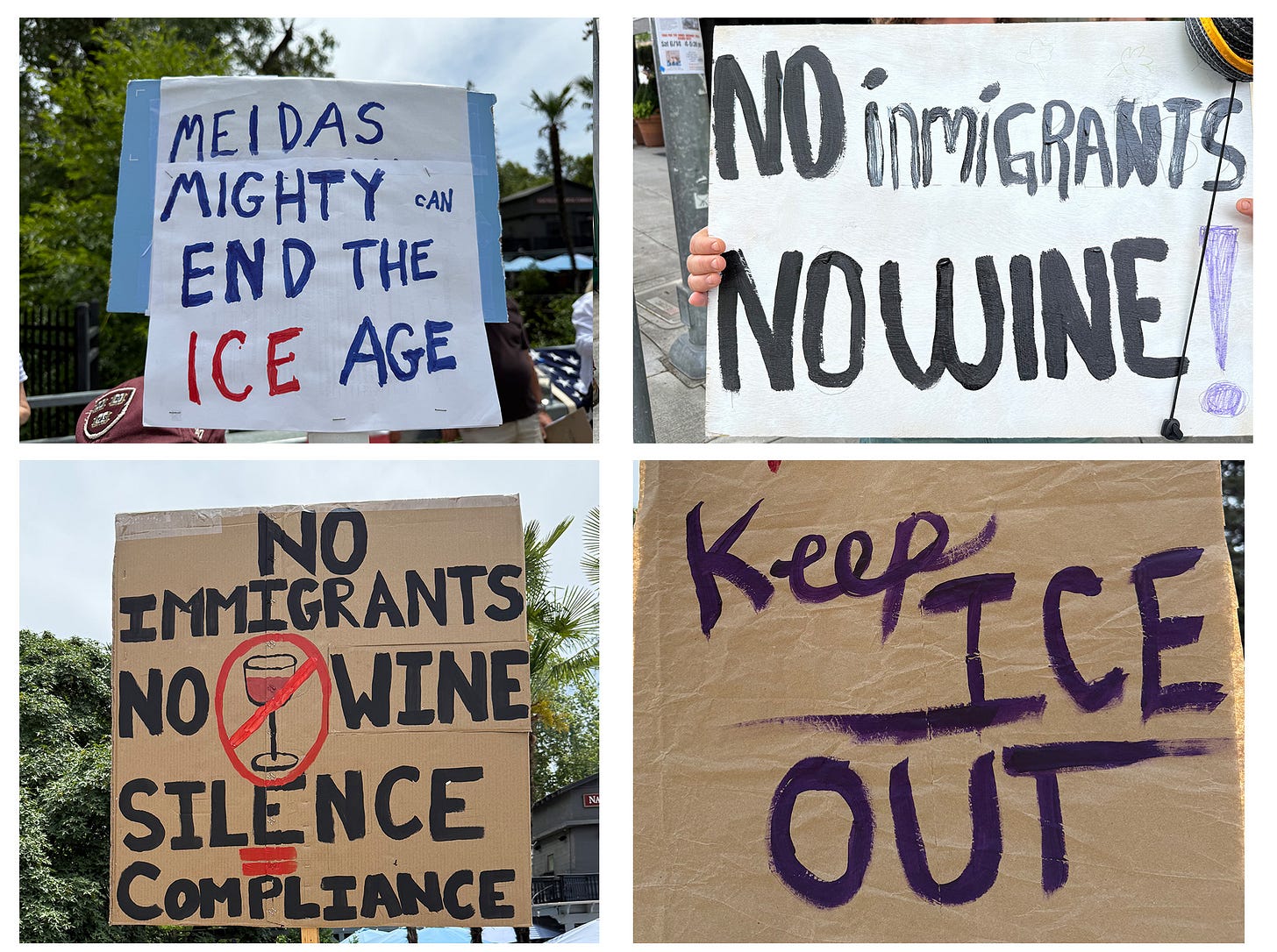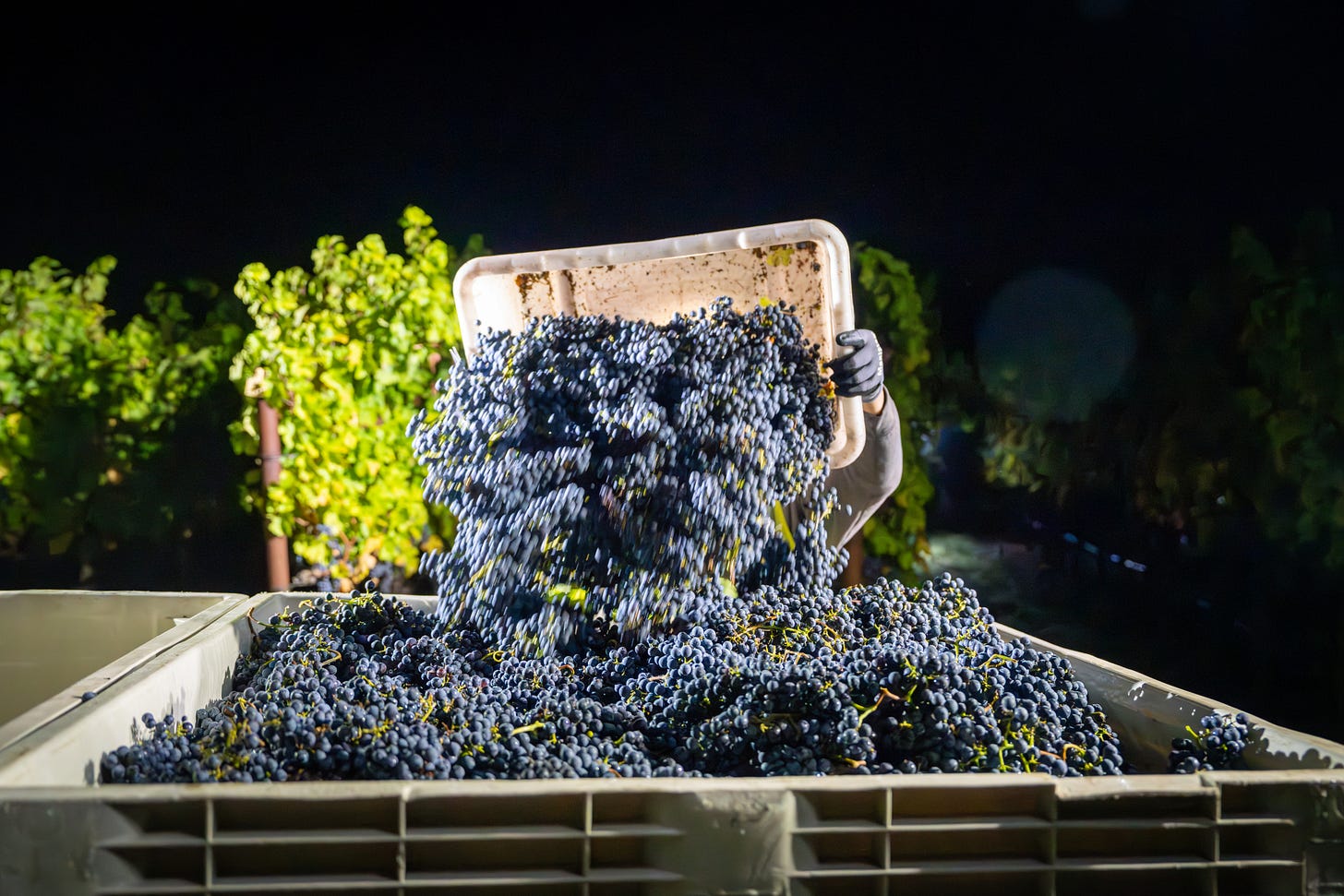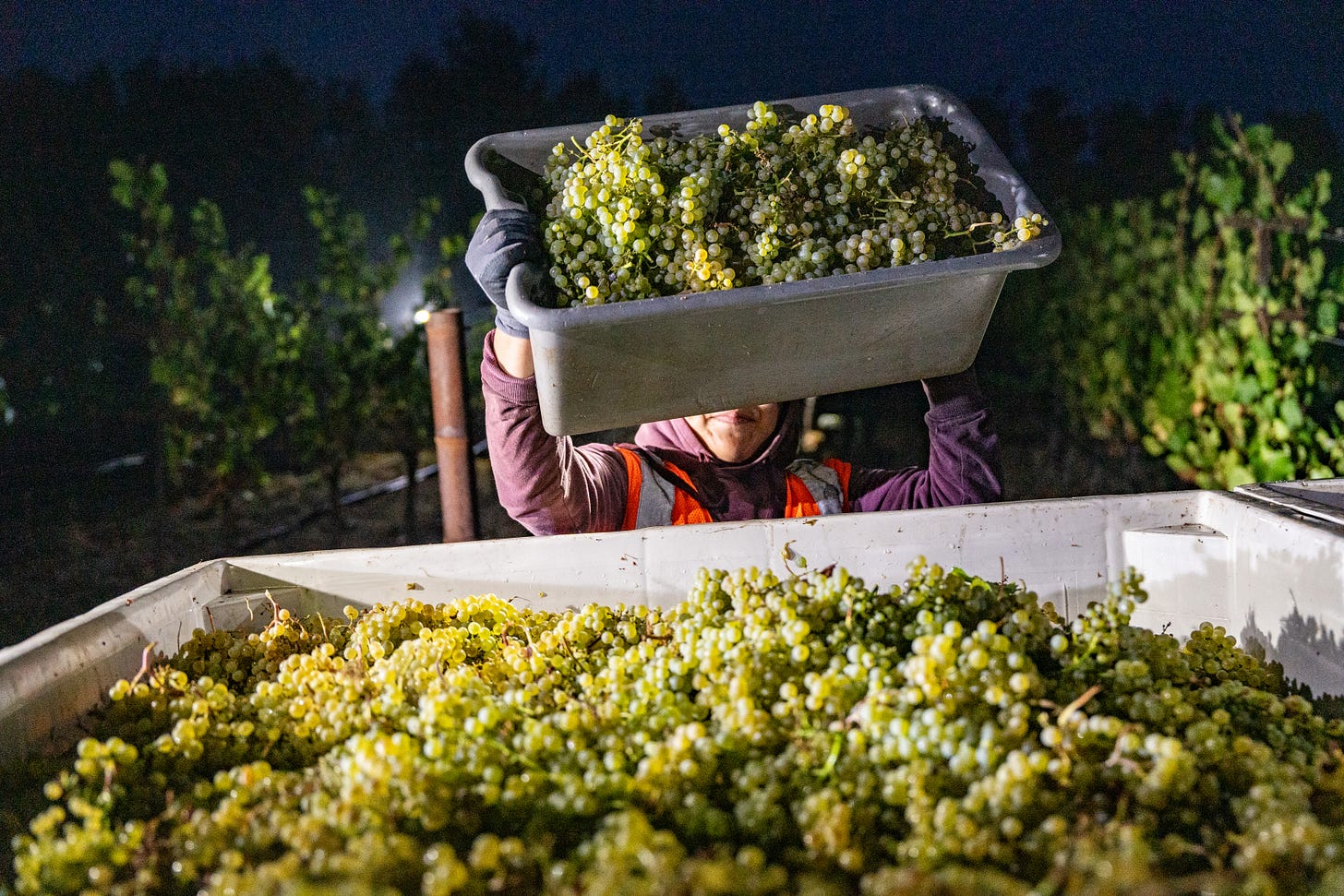Wine Chronicles: ICE’d Wine — 'No Immigrants, No Wine'
How immigration enforcement is unraveling Napa’s labor economy — By Tim Carl
Editor’s Note: While researching this article, we reached out to more than two dozen sources. Of the fewer than half who responded, nearly all requested anonymity, citing concerns for their own safety and that of their families and employees.

NAPA VALLEY, Calif. — There haven’t been any Immigration and Customs Enforcement (ICE) raids in Napa County this year — at least not yet. But you wouldn’t know it walking the vineyards, grocery store aisles or winery cellars.
The fear is here. And so is the fallout.
Nearly everyone we spoke with emphasized the importance of secure borders and the prosecution of criminal activity. But what is unfolding now goes beyond public safety — creating widespread fear and uncertainty across a workforce vital to the U.S. economy.
Across California’s Central Coast and up into Washington State, federal immigration enforcement has intensified in recent months. Raids in agricultural areas have pulled hundreds of long-standing workers from their communities. The impacts are immediate — missed harvests, delayed pruning, stressed crews — but the effects don’t stop at farm gates.
“The Guatemalans are going home,” said one grocery store worker in St. Helena who asked not to be named. “When ICE gets you, you lose everything. I hear you can’t even take your shoes. People would rather leave on their own terms.”
That shift — quiet, cautious and widespread — is hollowing out the labor backbone of California’s agricultural sector.
A Workforce on Edge
This past spring, immigration raids in Ventura County caused a 25% to 45% drop in farmworker attendance, particularly during strawberry and lemon harvests. In Kern County, up to 75% of citrus workers stopped reporting for shifts after news of ICE activity spread. Similar disruptions were recorded in Santa Barbara and San Luis Obispo counties.
And while Napa has so far avoided such direct enforcement, local vineyard managers and contractors say the damage is already being felt.
“I have never seen it this bad, ever,” said one Napa-based vineyard manager. “We have lost nearly half our crew, and I have no idea what we'll do for harvest.”
Workers have stopped commuting across county lines. Some have left altogether. Others, still here, are going silent — changing routines, skipping shifts, avoiding public life.
A significant portion of the U.S. agricultural workforce lacks legal status. According to the U.S. Department of Agriculture, about 42% of hired crop farmworkers nationwide lacked legal work authorization as of 2022. In California, estimates indicate that at least 50% of farmworkers are undocumented. In Sonoma County, the most robust recent data shows that more than half of farmworkers are undocumented. In Napa County, 73% of the agricultural workforce is foreign-born, with about 33% of the immigrant population estimated to be undocumented. With such a high proportion of the workforce lacking legal status, aggressive immigration enforcement could threaten livelihoods and potentially disrupt the entire agricultural economy in these regions.
But the disruption doesn’t end with the worker.
ICE raids throughout Southern California have reverberated through small agricultural towns, with families left unaware of where loved ones were taken, according to Decanter.
The Fear That Ripples
Immigration anxiety now reaches across households. Parents are pulling children from after-school programs and skipping school events. Families are avoiding weekend outings. Some won’t drive to work or the grocery store. A birthday party becomes a risk. A church gathering becomes a threat.
Take the case of Moises Sotelo-Casas, a respected Oregon vineyard manager and viticulturist who had lived and worked in the community for decades. On the morning of June 12, 2025, ICE agents detained Sotelo-Casas outside St. Michael’s Episcopal Church in Newberg, Oregon. He was placed in restraints (“chains at his feet,” his daughter said), stripped of personal items and transferred to the Northwest Detention Center in Tacoma, Washington. ICE officials cited a prior DUI conviction and past deportation as justification — but local records show only a minor speeding ticket from 1997.
The arrest sent shockwaves through vineyard crews across the West.
“The guy they took up in Washington had been there 20 years, maybe more,” one Napa laborer said. “Now nobody is safe — not even the ones who’ve been here forever.”
Even those with legal status or protected categories are affected. It’s no longer simply about documentation — it’s about visibility. For many, the safest move is to disappear.
Challenge your vocabulary with this week’s mystery word. Submit your answer in the poll, and check the bottom of the page for the correct answer.
Fragile Systems, Growing Cracks
Napa’s economy runs on immigrant labor. Vineyard and winery crews. Restaurant back-of-house teams. Hotel staff. Landscaping and maintenance. Construction and painting. Grocery and food processing.
When workers leave or retreat, every part of the economy slows. Tasting rooms cut hours. Cleaning services lose contracts. Builders delay jobs.
One restaurant owner said, “Staff is scared. We’ve put ‘Staff Only’ signs on kitchen doors and even added a ‘Stay in the Kitchen’ button to our POS system — so if ICE shows up, the waitstaff can warn the kitchen.”
In California, including Napa County, ICE agents cannot legally enter non-public areas of a business without a judicial warrant signed by a judge. Administrative warrants do not grant this authority. As a result, measures such as marking private areas, locking doors and training staff to recognize valid warrants are widely used as improvised layers of protection — helping ensure that workers and employers are not caught off guard and that their rights are respected.
Some growers are trying to bridge the gap with H-2A guestworker visas, but the program is expensive and limited. A 2024 University of Georgia study found that H-2A workers effectively cost $30/hour after accounting for housing, travel and administrative burdens — pricing many small producers out.
While immigration debates often focus on raw numbers, it’s worth noting that immigrant labor has long been a constant in the U.S. economy. As this national trend shows, even as the immigrant population has grown in absolute numbers, immigrants as a share of the total U.S. population has remained relatively stable over time. Napa’s deep reliance on immigrant labor today is part of a much longer national pattern — one that continues to shape who does the work, and under what conditions.

For vineyard owners struggling to find enough workers, mechanization can help in certain locations, but on hillside and premium vineyard blocks where precision matters, machines can’t replace experienced hands and there is a stigma regarding the use of machines.
Meanwhile, fewer new workers are coming. A 2025 UC San Diego report showed declining immigration from Mexico and Central America, citing both enforcement pressure and shrinking economic incentives.
The effects are not limited to agriculture. Across sectors that rely on immigrant labor — from hospitality to healthcare — the strain is deepening. According to recent reporting by Axios, the immigration crackdown is now rippling into long-term care. Nationwide, more than 40% of home health aides and nearly one-third of nursing assistants and personal care aides are foreign-born. As deportations and labor shortages spread, nursing homes and in-home healthcare providers are losing workers at a time when shortages were already severe — threatening care for the nation’s most vulnerable.
One Napa Valley hotel owner said, “I’m not aware of any staff member or their family being questioned or detained. But the fear is palpable. ‘ICE is coming for everyone’ is the feeling I get from Hispanic staff. Any unmarked van or SUV now sparks fear.”
A Rattled Industry
In June 2025, President Trump ordered U.S. Immigration and Customs Enforcement to intensify deportation efforts in cities. In a formal statement, he wrote:
“We must enhance efforts to apprehend and expel Illegal Aliens in America’s largest cities, including Los Angeles, Chicago and New York, where millions upon millions of Illegal Aliens reside….These cities and others like them are the epicenter of the Democrat Power Center, where Illegal Aliens are exploited to bolster their voter base, manipulate elections, and expand the welfare system, thereby depriving hardworking American citizens of well-paying jobs and benefits.” (Source)
He further directed ICE, Border Patrol and federal law enforcement to focus on “crime-ridden and dangerous inner cities” and areas “where Sanctuary Cities play such a significant role.”
Many interpreted the move as a strategic attempt to quell growing backlash from farm-state and business leaders who warned that stepped-up workplace enforcement was crippling the agricultural and hospitality sectors. By publicly shifting attention to urban centers, the administration appeared to offer rural employers a reprieve — at least temporarily.
But in Napa the shift brought little relief. Napa County is officially listed as a sanctuary jurisdiction under California’s SB 54, also known as the California Values Act, which limits local law enforcement cooperation with federal immigration agencies except under specific circumstances. The county appears on the Center for Immigration Studies’ national list of sanctuary jurisdictions and is aligned with state policies that prioritize community trust over immigration enforcement. Yet that status hasn’t eased fears. Instead, many in Napa say recent federal messaging has deepened uncertainty. Even in counties with sanctuary protections, federal enforcement remains unpredictable — driven less by local priorities or economic realities than by shifting signals from Washington.
“Even if they pause now,” one grower said privately, “we all know they can flip the switch again. Nothing about this feels stable.”
Breaking News Note: Just hours before this article went to press, ICE reversed its earlier directive pausing worksite raids. Agents are now reauthorized to target farms, hotels, restaurants and related businesses, with DHS sources confirming the White House has set an internal goal of 3,000 arrests per day nationwide.
According to Decanter, many businesses have responded by training staff to differentiate real from fake warrants, locking vineyard gates and clearly marking private property to protect crews.
The result isn’t just economic uncertainty and fear — it’s strategic paralysis. Vineyard managers are struggling to plan for the upcoming harvest. Some are planning to leave lower-quality blocks unpruned and maybe even unpicked. Others are gambling on small crews or unreliable labor, hoping for the best.
At the same time, proposed increased tariffs on Mexican imports threaten to further erode the economics of seasonal migration, pushing many to remain in Mexico or avoid travel altogether.
Blurring the Badge
Compounding the fear is a growing confusion between local law enforcement and federal immigration agents. ICE officers, often wearing vests labeled “POLICE,” have long been mistaken for city or county officers — a practice that critics say erodes trust and chills community cooperation.
Rep. Mike Thompson has consistently raised alarms over this issue. This month, he co-introduced legislation that would prohibit ICE and other federal immigration agencies from wearing uniforms marked “police,” arguing that the practice misleads the public and undermines public safety.
“When immigrant communities see ‘police’ on an ICE individual’s uniform … it creates problems,” Thompson said. “It puts people at risk. If there’s an immigrant who is a victim of a crime, they’re reluctant to report it.”
California legislators have echoed this concern with a new state bill that would also ban ICE agents from wearing face coverings like masks or balaclavas during enforcement operations and require clear identification — part of a broader effort to distinguish local officers from federal agents in the eyes of residents.
For those who harvest grapes, clean hotel rooms, cook food or keep Napa’s economy running in countless unseen ways, this uncertainty is more than emotional — it’s existential.

Rallies and Resistance
Over the past weekend, Napa Valley residents took to the streets during the No Kings rallies. Events in Calistoga and downtown Napa drew hundreds and thousands, respectively — marking one of the largest recent public demonstrations in the region.
Protesters carried signs that read: “No immigrants, no wine.” “We are all immigrants.” “ICE Not Welcome Here,” and “The Wrong ICE is Melting.”
In December 2024, the Napa County Board of Supervisors publicized and endorsed the Rapid Response Hotline (707-800-4544) as a resource for reporting ICE activity and accessing legal support. The hotline itself is operated by the North Bay Rapid Response Network.
“At the Board of Supervisors, we’ve been clear in our support for our immigrant community,” said Joelle Gallagher, Napa County Supervisor for District 1. “We passed a resolution in December, we’ve talked about it in board meetings. But we need to hear clear and compelling words of support from every industry and sector across the county. Silence is not okay.”
We reached out to the region’s major wine industry groups — including the Napa Valley Grapegrowers, Napa County Farm Bureau and Napa Valley Vintners. As of publication, only the Farm Bureau has provided a formal response. In a statement issued June 18, the Napa County Farm Bureau aligned itself with state and national Farm Bureau positions calling for “practical, compassionate solutions” and warning that “blanket enforcement measures put the entire agricultural system at risk.” The Farm Bureau also shared employer resources for handling enforcement actions (Farm Employers Labor Service guidance shown below) and pointed to the Immigration Institute of the Bay Area as a valuable resource for local employers and workers.

We found no currently available public statements or official guidance from NVV or NV Grapegrowers addressing the recent ICE raids. However, according to Supervisor Joelle Gallagher, agricultural leaders — including those from the Farm Bureau and Grapegrowers — publicly supported the Board of Supervisors’ December 2024 resolution on inclusivity and immigrant protections.
In dozens of conversations with vineyard and winery workers, owners and managers, few agreed to speak, even off the record. Some explicitly said they feared retaliation — from federal authorities, employers or the public — if they were named or implicated. What they did share points to a pattern: Individual growers are quietly locking gates, marking property lines, keeping a low profile and training crews to recognize valid warrants. These efforts are improvised, uncoordinated and supported by limited formal industry guidance.
The absence of a unified response appears rooted in political caution or quiet compliance — and underscores a deeper truth: Napa’s wine industry runs on immigrant labor. And right now, much of that workforce is gripped by fear, uncertain of who their allies are or where to turn.
The Harvest Ahead
Harvest is just weeks away, but this year, it’s more than fruit that hangs in the balance.
No immigration raids have been reported in Napa County so far. But the effects of enforcement elsewhere are already influencing decisions here. Without clear policy signals or coordinated support, businesses are left to improvise — and workers to weigh risk against routine.
The erosion of Napa’s labor force is no longer a projection. It’s unfolding in real time — in understaffed crews, shifting schedules and the growing likelihood of delayed harvests that could compromise both quality and quantity. The most skilled workers — those who have tended these vines for years — are leaving or keeping their heads down.
What’s at stake isn’t just the outcome of this year’s vintage, but the trust, stability and human infrastructure that the region’s wine industry depends on.
“This isn’t just about labor — it’s about people. Families. Friends. Neighbors,” Gallagher said. “We’re socially and economically interdependent. If you come for one of us, you come for all of us.”
—
Tim Carl is a Napa Valley-based photojournalist.
Wine Discovery:
2024 LOLA Artisanal Series St. Helena Albariño ($45) — From a six-acre, organically farmed vineyard on Zinfandel Lane at the southern edge of St. Helena, this albariño is whole-cluster pressed and fermented in neutral French oak without fining or filtration. Aromatics lead with green mango, wet stone, lemongrass and quince. The palate is dry and crisp, carrying a subtle creaminess that rounds out its mouthwatering, steely acidity. 12.5% alcohol — light and vibrant. Serve with shrimp ceviche, grilled scallops or Vietnamese rice paper rolls. — Tim Carl
Today’s Polls:
This Week's Word Challenge Reveal:
The correct answer is C: "Transition phase in a process." The word "liminality" derives from the Latin līmen, meaning "threshold" — a physical boundary between spaces, such as a doorway. The term entered academic discourse in the early 20th century through the work of French ethnographer Arnold van Gennep, who coined the concept of "liminal" phases in his 1909 study Les Rites de Passage. He used it to describe the middle stage of ceremonial transitions, where participants are no longer in their previous state but not yet in their new one.
In the 1960s, British anthropologist Victor Turner further developed the idea, emphasizing liminality’s role in social transformation and community formation. Over time, the term has migrated into broader use in the humanities, psychology and cultural theory, often describing moments of ambiguity.


























Another excellent article, Tim. Keep it up. When the traditionally hyper conservative Farm Bureau calls for compassion and pragmatism in ICE enforcement, you know something is amiss in the administration's politics. Cruelty and racism seem to be a deep-seated instinct in the current administration's policies, far beyond immigration. It includes the dismantling pf USAID, public health cutbacks like Medicaid, and more. Thank you for keeping important issues in front of public attention. As you note, resistance is rising and that gives hope that the political distemper sweeping this country may yet be brought back under control.
As the impacts of reduced labor force become increasingly evident, perhaps one can hope that this administration will temper its shoot-first-ask-questions-later MO.